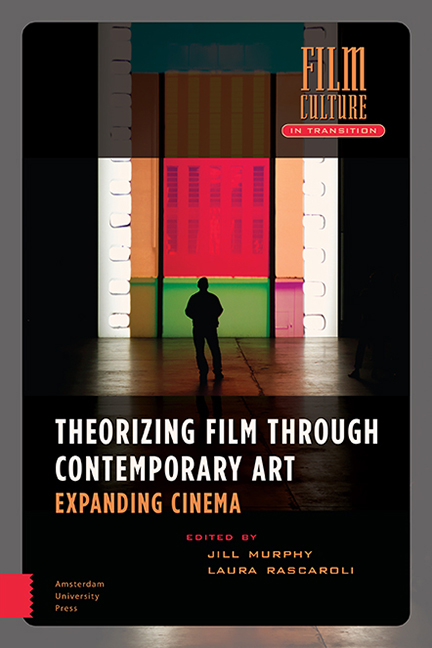Book contents
- Frontmater
- Dedication
- Contents
- List of Illustrations
- Acknowledgments
- Foreword: Courtesy of the Artists
- Introduction: On Cinema Expanding
- Part One Materialities
- 1 Cinema as (In)Visible Object; Looking, Making, and Remaking
- 2 Objects in Time; Artefacts in Artists’ Moving Image
- 3 Materializing the Body of the Actor; Labour, Memory, and Storage
- 4 How to Spell ‘Film’; Gibson + Recoder’s Alphabet of Projection
- Part Two Immaterialities
- 5 The Magic of Shadows; Distancing and Exposure in William Kentridge’s More Sweetly Play the Dance
- 6 Douglas Gordon and the Gallery of the Mind
- 7 A Throw of the Dice Will Never Abolish Chance; Tacita Dean’s Section Cinema (Homage to Marcel Broodthaers)
- Part Three Temporalities
- 8 The Photo-Filmic Diorama
- 9 The Cinematic Dispositif and Its Ghost; Sugimoto’s Theaters
- 10 Time/Frame: On Cinematic Duration
- Part Four The Futures of the Image
- 11 Interactivity without Control; David OReilly’s Everything (2017) and the Representation of Totality
- 12 Post-Cinematic Unframing
- 13 Absolute Immanence
- Index
Foreword: Courtesy of the Artists
Published online by Cambridge University Press: 23 June 2021
- Frontmater
- Dedication
- Contents
- List of Illustrations
- Acknowledgments
- Foreword: Courtesy of the Artists
- Introduction: On Cinema Expanding
- Part One Materialities
- 1 Cinema as (In)Visible Object; Looking, Making, and Remaking
- 2 Objects in Time; Artefacts in Artists’ Moving Image
- 3 Materializing the Body of the Actor; Labour, Memory, and Storage
- 4 How to Spell ‘Film’; Gibson + Recoder’s Alphabet of Projection
- Part Two Immaterialities
- 5 The Magic of Shadows; Distancing and Exposure in William Kentridge’s More Sweetly Play the Dance
- 6 Douglas Gordon and the Gallery of the Mind
- 7 A Throw of the Dice Will Never Abolish Chance; Tacita Dean’s Section Cinema (Homage to Marcel Broodthaers)
- Part Three Temporalities
- 8 The Photo-Filmic Diorama
- 9 The Cinematic Dispositif and Its Ghost; Sugimoto’s Theaters
- 10 Time/Frame: On Cinematic Duration
- Part Four The Futures of the Image
- 11 Interactivity without Control; David OReilly’s Everything (2017) and the Representation of Totality
- 12 Post-Cinematic Unframing
- 13 Absolute Immanence
- Index
Summary
Expanding cinema by means of theorizing film through contemporary art. Expanding it, that is, by theorizing-film-through something other than film itself and yet in affinity with it. The cinematic affinities in contemporary art as the occasion through which theorizing film projects itself into an expanding cinema that promises to become the theoretical apparatus par excellence of a new dispositif for its expanding theory. In expanding cinema through contemporary art the expanding theory preserves the legacy of theorizing-film-through-film by other means. The ever-expanding dispositif of theorizing-film-through-art reinstalls itself in the new installation, namely, from the cinema to the gallery. The coming attraction, or rather distraction, is no doubt the post-cinematic condition of possibility for its own projection performance: theorizing contemporary art through film. Whether the dispositif of theorizing-film-through-art takes hold of the dispositif of theorizing-artthrough- film as the uncanny shadow of its shadow is a possibility among possibilities in the throw of the thematic scope outlined in the handsomely edited volume before you. A retrospective foreword by way of a collection of aphorisms in the form of artist statements, proposals, and correspondences from our collaborative work as Gibson + Recoder registers the vertiginous twists and turns of a threading path entangled in the light spill of an expanding cinema: Theorizing Film Through Contemporary Art.
In our installation work, we use projected light to articulate space and time. Film projectors and celluloid are the material base of our constructions in light and shadow, the elemental properties of cinema. These things are deeply imbued with a history of viewership in the dark of the theatre. To remove it from darkness is to flood this history and cast a certain illumination upon it. A certain exposure. Light spills in the shifting of film from its native darkness in enclosed chambers (camera obscura) to the uncanny openness and defamiliarized illumination of installation. We are exploring the shift, elaborating the displacement, recasting the light mechanics of a peculiar estrangement of the medium. The art of cinema, yes. But more timely: the becoming cinema of art. That is the coming attraction for us.
- Type
- Chapter
- Information
- Theorizing Film Through Contemporary ArtExpanding Cinema, pp. 15 - 32Publisher: Amsterdam University PressPrint publication year: 2020



